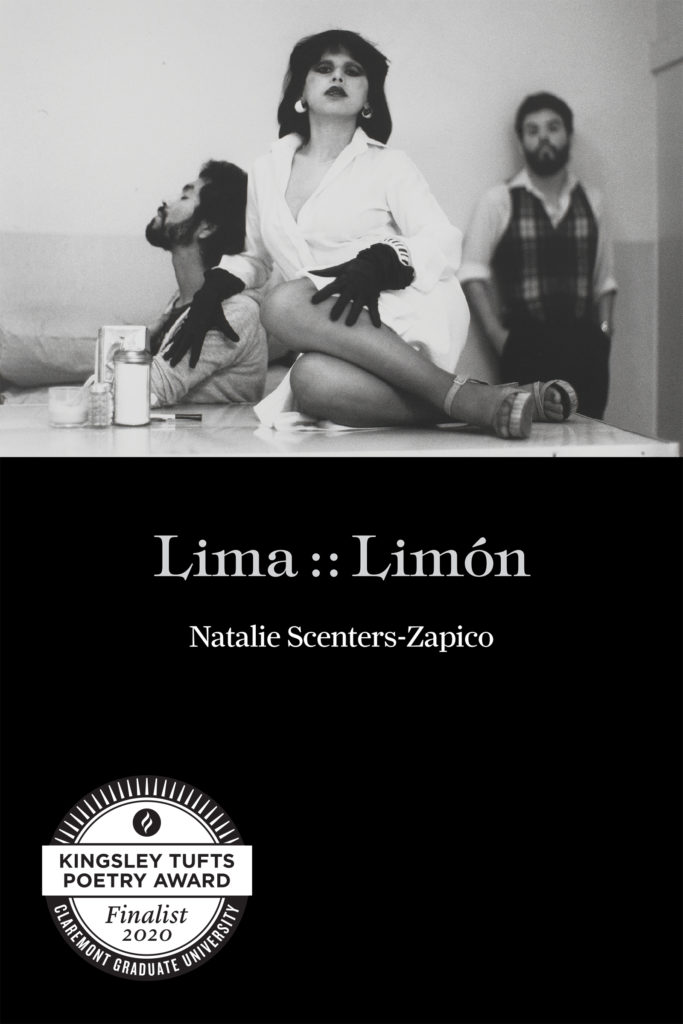Poetry as Disruption: A Review of Natalie Scenters-Zapico’s Lima :: Limón

Lima :: Limón (Copper Canyon, 2019) is Natalie Scenters-Zapico’s second book of poetry and was selected as a finalist for the 2020 Kingsley Tufts Poetry Award. This powerful work traverses the boundaries of Mexico and the United States and is reflective of Scenters-Zapico’s upbringing in El Paso, Texas and Ciudad Juárez, Chihuahua, México. While it blurs national boundaries, Lima :: Limón powerfully questions gendered boundaries as well. This work represents social disruption in a way that only the most moving poetry can do. The cover art immediately sets the stage for the commanding sensual female authority that touches each page. Scenters-Zapico provides the reader with poetry as protest, and then asks one to question the ownership of nation, body, and language in a profound way.

I was particularly struck by “Aesthetic Translation” and its illustration of the femicide on the US-Mexico border. Scenters-Zapico shows the ways in which women are expected to understand and overcome no matter what the circumstances. As the obituaries of the women in Juarez teaches her how to read, she states, “There were / so many people I could never finish / the section before leaving for school” (29). This moment of recognition of the slain women disrupts the speaker’s journey to school. The poem examines how the ghastly violence in Juarez disrupted everyday life and as the poem continues, it shows how the narrative provided by Charles Bowden disrupts the national understanding of the tragic situation. Bowden, a Los Angeles Times reporter who covered the US-Mexico border for decades and eventually wrote a (problematic) novel based around his reporting, stands between the female understanding of the violence and the pervasive American narrative. The speaker proclaims, “He won’t let women / speak. Even after death, he / depends on the desert’s shroud” (30). As this poem points out, men have translated and continue to translate the world for the women who have been forcibly subjected to brutal violence. Scenters-Zapico shows how the power of translation can be reclaimed for women in her work. However, it is not an easy task as the poem ends with, “I’ve died. I swear I was born / dead again” (31). In this ending, the poem even disrupts the binary between life and death.
Further examining the femicide along the US Mexico border, “The Women Wear Surgical Masks” depicts the processions of women mourning and protesting the deaths of thousands of their peers. Reflecting back on “Aesthetic Tradition,” Scenters-Zapico writes, “I don’t want to turn these women into an aesthetic. / I have failed” (39). In a great moment of self-reflexivity, the poem questions the ability of poetry to present tragedy at such a scale. Is there a way to write poetry that works as a fitting tribute of something so awful? In this moment of humbled reflection, Scenters-Zapico sets herself apart in her ability to do so. She ends the poem complicating her poem as well as the protest it describes: “This poem, my failed / re-creation—their protest a failed resuscitation” (40). Again, as she did in “Aesthetic Translation,” her work exemplifies the often-disheartening battle for women to gain power over their own narrative.
I have only discussed two of my favorite poems from this work, but Lima :: Limón is filled with strong poems that disrupt binary structures and exemplify how poetry can move beyond aesthetic representation of tragedy. Even as Scenters-Zapico’s work questions itself, it only further solidifies its ability to transform and reclaim the narrative surrounding femicide and violence against women along the US Mexico border. I am thrilled that it is a finalist for this year’s Kingsley Tufts Poetry Award, and I cannot recommend it enough.
—Jordan Wheatley
Share